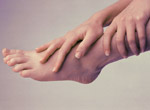Diabetes and Your Feet: Prevention is Key!
Posted by: Jonathan Robinson on April 21, 2010
 Today, there are an estimated 2 million Canadians living with Diabetes and 60,000 new cases of diagnosed Diabetes every year. Many more people display undiagnosed symptoms that can lead to this terrible disease. The incidence of diabetes is on the rise! Our focus at ABLE is to help you stay active and healthy; so you can enjoy life. For the Diabetic, applied knowledge and diligence towards foot care can have a dramatic impact on your quality of life.
Today, there are an estimated 2 million Canadians living with Diabetes and 60,000 new cases of diagnosed Diabetes every year. Many more people display undiagnosed symptoms that can lead to this terrible disease. The incidence of diabetes is on the rise! Our focus at ABLE is to help you stay active and healthy; so you can enjoy life. For the Diabetic, applied knowledge and diligence towards foot care can have a dramatic impact on your quality of life.
Medical studies show that Diabetes has a debilitating effect on the extremities, most often the feet. In simple terms, this debilitation is due to a combination of impaired nerve and circulatory function.
- Reduced blood circulation occurs as the arteries, both small and large, become blocked. The result is decreased healing power, which is the main reason why diabetic patients take so long to heal once a problem has begun. As a result a simple blister can develop into an ulcerated lesion that will be difficult to treat and very slow to heal.
- Impaired nerve function or neuropathy involves the loss of sensation in the nerves that supply the lower leg and foot due to altered blood glucose levels. In fact, research has demonstrated that 60-70% of the people with diabetes have mild to severe forms of nerve damage to their feet. With the loss of sensation, the danger is that the diabetic patient can have a simple scratch or irritation that goes unnoticed and develops into a foot ulcer.
The combined effect of impaired nerve and circulatory function can put diabetics at risk of developing a foot ulcer which can escalate and result in the amputation of a foot or leg. Of all the diabetics admitted to hospitals, over 20% of them are there because of foot problems. The American Diabetes Association reports that 15% of all people with diabetes will eventually develop foot ulcers and that these ulcers frequently become infected and lead to amputation. In addition 50% to 70% of all non-traumatic amputations occur in patients with Diabetes. Thankfully, many of the potential problems can be prevented with proper foot care.
Prevention is the Key:
Aggressive care of the diabetic foot can often offset or alleviate potentially painful and irreversible damage that can decrease the quality of your life forever.
Footcare:
- Check your feet daily by visually inspecting them. Be alert for: redness, swelling, broken skin, sores or bleeding. See your doctor immediately if any of these problems arise
- Wear shoes around the home, indoors as well as outdoors, to protect your feet from injury
- Wash your feet with soap and warm water every day, but do not soak them
- Avoid heat pads or hot water bottles even though your feet might get cold easily. With a lack of sensation it is easy to burn the feet without noticing if the water is too hot
- Avoid socks with heavy seams, as they can cause irritation of the skin and lead to breakdown or ulceration
- Avoid tight constrictive socks and clothing that can limit blood flow to the extremities
- If you have a problem with lower limb swelling, graduated compression stockings can help control swelling and improve the fit of shoes over the course of a day
Shoe Selection: Get good shoes! Key features for diabetic footwear include:
- soft uppers with minimal seams. Particularly avoid seams over the toe area of your shoes. Seams resist stretching and create bumps that can rub against the skin and cause it to break down or ulcerate
- deep and wide toe boxes to reduce abnormal pressure
- firm but cushioned soles
- removable insoles
- a strong heel counter
- rockered sole
- Lace up shoes offer a versatile fit and should be used, if possible. Alternatively, use Velcro closures if tying laces is difficult.
- Avoid slip-on and restrictive footwear, such as high heels with pointed toes or shoes that are narrow in style, as they depend on a tight fit to stay on the foot
When Fitting shoes:
- Have your shoes fitted properly by a trained specialist such as a Canadian Certified Pedorthist
- Remove the insole from the shoe and stand on it to see if your foot overlaps the insole, indicating that the shoe is too narrow or short for your foot
- There should be a full finger width between the end of the longest toe and the end of the shoe


